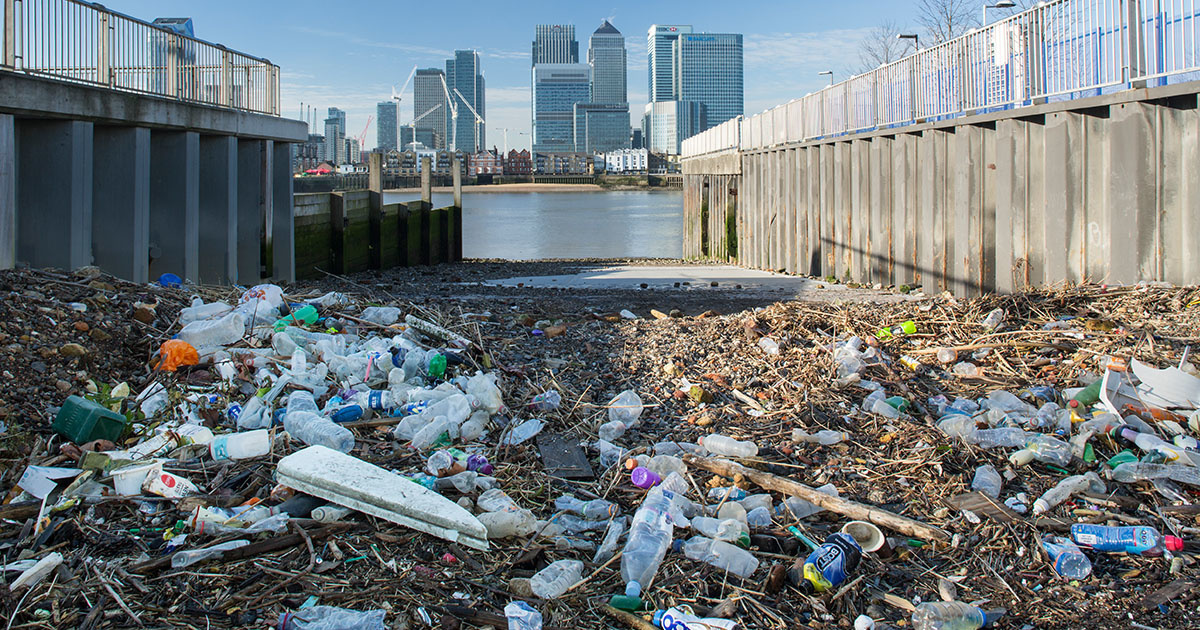

Litter washed up by the tide of London's Thames River. Anthony John West / Getty Images
Most of the 8 million tons of plastic that enter the world’s oceans each year flows from rivers, but fewer studies have been done looking at plastic pollution in freshwater environments. The Plastic Rivers report released Monday by the EarthWatch Institute and Plastic Oceans UK Monday looks to correct that knowledge gap and help consumers understand the best actions they can take to keep plastic out of the world’s waterways.
The report reviewed nine studies of pollution in European and UK rivers and lakes to find the top 10 single-use plastic items. Of the 193,238 items turned up in the studies, 37.5 percent were plastic items normally used by consumers. The rest of the litter was related to agriculture, fishing or industry.
Top 10 plastic pollutants in rivers and lakes revealed! Find out how you can have a real impact on #plasticpollution using our new evidence-based study #PlasticRivers #plasticcleverhttps://t.co/Bw0ekuszUW
— Earthwatch Europe (@Earthwatch_Eur) April 8, 2019
The top 10 list accounted for 28.2 percent of all the litter in the studies. The two organizations then compared environmental evidence and the life cycle of each item to advise concerned users on how best to prevent more of them from ending up in rivers and, eventually, oceans.
The list is as follows:
1. Plastic Bottles
Percentage of Total Plastic Litter Found: 14 Percent
Recommended Action: Use Reusable Bottles
2. Food Wrappers
Percentage of Total Plastic Litter Found: 12 Percent
Recommended Action: Dispose of Them Properly
3. Cigarette Butts
Percentage of Total Plastic Litter Found: 9 Percent
Recommended Action: Dispose of Them Properly
4. To-Go Containers
Percentage of Total Plastic Litter Found: 6 Percent
Recommended Action: Use Reusable Containers for Take-Out
5. Cotton Bud Sticks
Percentage of Total Plastic Litter Found: 5 Percent
Recommended Action: Use Buds With Paper Sticks Instead
6. Cups
Percentage of Total Plastic Litter Found: 4 Percent
Recommended Action: Use Reusable Cups
7. Sanitary Items
Percentage of Total Plastic Litter Found: 3 Percent
Recommended Action: Do Not Flush Pads, Tampons or Wet Wipes
8. Cigarette Packaging
Percentage of Total Plastic Litter Found: 2 Percent
Recommended Action: Dispose of It Properly
9. Plastic Straws, Stirrers and Cutlery
Percentage of Total Plastic Litter Found: 1 Percent
Recommended Action: Use Reusable Silverware and Straws
10. Plastic Bags
Percentage of Total Plastic Litter Found: 1 Percent
Recommended Action: Use Reusable Bags
Our new #PlasticRivers report with @Earthwatch_Eur names plastic bottles the BIGGEST culprit clogging up our waterways. Check out this infographic which gives you the shocking truth behind plastic bottle pollution! Read the report in full: https://t.co/LPQfcNqrEp pic.twitter.com/Bc5pp5Zhcd
— Ocean Generation (@oceangen_) April 9, 2019
The low placement of plastic bags indicated that efforts in the UK and Europe to reduce their use through fees and other measures has paid off, The Guardian reported. However, the report also shows the persistence of other plastic items in daily life.
“The products we buy every day are contributing to the problem of ocean plastic,” Plastic Oceans UK Chief Executive Jo Ruxton told The Guardian. “Our discarded plastic enters rivers from litter generated by our on-the-go lifestyle and items we flush down toilets. This throwaway approach is having much more serious consequences and the report shows really simple ways to avoid this problem and stop plastic pollution.”
The report comes a little more than a week after the EU Parliament agreed to ban the most harmful single use plastics by 2021. Some of the items on the Plastic Rivers list, like plastic cutlery, straws and cotton buds, are covered by the ban. The law also sets new targets for the collection of plastic bottles and requires cigarette companies to pay for removing butts from waterways.
#EU Agrees to Slash Single-Use #Plastics to Halt Marine #Pollution https://t.co/fbdqPX705N @PlasticPollutes @PlasticOceans
— EcoWatch (@EcoWatch) December 19, 2018

 233k
233k  41k
41k  Subscribe
Subscribe 